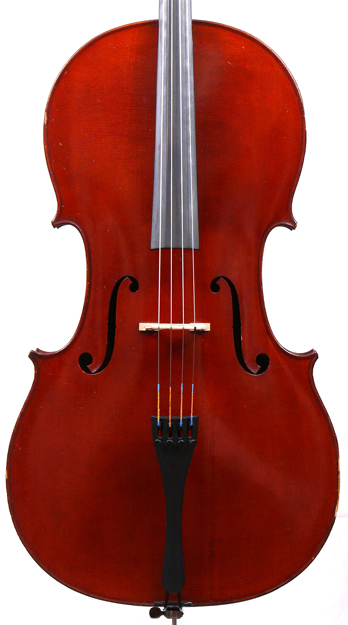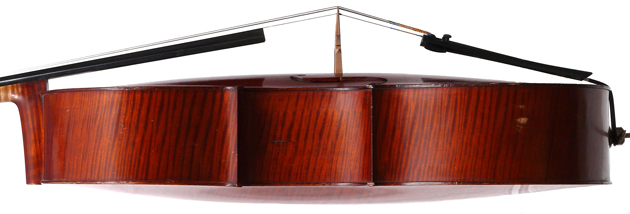Ref : 0610
A fine French cello by
Silvestre & Maucotel
Made for Sir Willem van Hulsteyn
Paris, 1902
This cello was made for Sir Willem van Hulsteyn in 1902. Sir Willem (born in Holland in 1865) was a prominent lawyer in South Africa and superb concert cellist who also owned a Stradivari cello, which (it is reputed) was later was used by Pablo Casals. (This information was obtained from the 1937 publication Saint Cecilia goes South, by Sir Percy Buck. However, it is known that Casals never owned a Stradivari and mainly played on a Matteo Goffriller.) Sir Willem was an important personality, who amongst other things, defended Indian rights in 1907 and who served on many commissions.This cello was recently discovered in a state of complete oblivion and has been restored to a pristine condition. It is the product of the collaboration between the French luthiers H. C. Silvestre and Ernest Maucotel, made in Paris in 1902, with serial number 469. An additional inscription to the label indicates that it was made for Sir Willem van Hulsteyn in Johannesburg (see photo). The instrument is also branded on the inside with Silvestre & Maucotel's brand. It can safely be assumed that the makers were aware of the fact that Van Hulsteyn also owned a Stradivari, and that they would have taken care to supply Sir Willem with a fine instrument of comparitive quality.
Both these makers are very important in the French school of violinmakers:
Hippolyte Chrétien SILVESTRE (1845-1913) was a nephew and pupil of the master luthier, Pierre Silvestre in Lyon. He initially worked for Pierre & Hippolyte Silvestre and took over their workshop in 1865. He moved to Paris in 1884, where he traded as 'Silvestre neveu'. In 1900 he became associated with Ernest Maucotel. Maucotel was earlier working for his uncle in Moscow. It was at Silvestre's insistence that Maucotel returned to Paris to work for the latter. Their collaboration lasted until Silvestre's death in 1913.
Ernest MAUCOTEL (b. 1867) initially was a pupil of Paul Bailly, but continued his studies in violinmaking in Moscow under his uncle, E. A. Salzard. Silvestre invited him back to Paris where he was principal violinmaker in Silvestre's workshop, and thereafter, in April 1900, became his business associate. After H. C. Silvestre's death in 1913 he continued on his own until 1922, when he became associated with the distinguished expert, Paul Deschamp, with whom he had a long and successful collaboration.
This is a splendid cello which conforms largely to the characteristics normally associated with the traditions of good French Lutherie: The two-piece back, ribs, neck and scroll are of well-flamed maple with a medium to narrow distinct curl, showing an excellent choice of materials. The front is of fine medium grained tone spruce. Varnish is a reddish brown - highly characteristic of the mainstream French school. The edges of the scroll are outlined in black - a French tradition, but sometimes also adopted by English makers. The arching is quite low.
As it is now the cello is in excellent condition and is an excellent example of the collaboration between these two important French luthiers. It also certainly has historic value inasmuch as it was made for a prominent historic figure. It has probably not been played on for about 40 or 50 years. It is sold with its original case, which was made especially for it and into which it fits exactly.
This cello has superb tone - clean, even and responsive. It is notably a fine solo instrument.
 |
 |
 |
||
 |
Condition : The cello has hardly been used and is almost entirely the way it was made. It comes with its original case, made especially for it. The only evident repairs to the cello is to a crack running down next to the tailpiece to the edge - the repair is virtually invisible and shows the hand of a very skilled restorer. It has been cleated on the inside. Four more cleats are attached on the inside over the back's centre line - two at the top and two at the bottom of the centre line. The wingcrack to the treble f-hole has been secured by a patch on the inside. All this work is very well done - probably by the prominent Dutch violinmaker, J J van de Geest who was resident in Johannesburg until 1974.
It appears also that the left lower corner on the front sustained some damage and has been restored.
Provenance : Made for and initially owned by Sir Willem van Hulsteyn in 1902. Ownership thereafter is not known until this cello became part of the Hans Adler Collection in about 1965. (The Hans Adler Collection consisted mainly of rare, unusual and high-profile instruments, mostly keyboard.) Upon Hans Adler's death in 1979, the collection was bequeathed to the Music Department of the University of the Witwatersrand in Johannesburg. In 2011 the cello was bought from that University by Johan Grobbelaar who now owns it.
Price : Available on request. It is interesting to note that in March 2011 a cello by Pierre Silvestre (H C Silvestre's uncle and teacher) was sold for £42 500 (about R480 000)
 |
 |
 |
 |
 |
 |
 |
 |
 |
 |
|||||